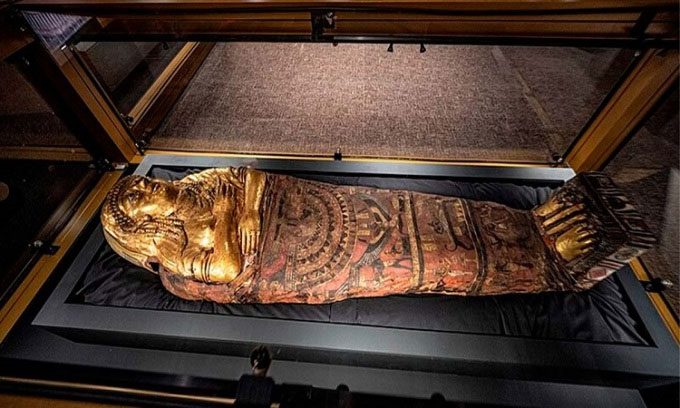Archaeologists have discovered the mummified remains of a wealthy woman dating back nearly 2,000 years, yet her identity remains a mystery.
William Matthew Flinders Petrie is one of the most renowned Egyptologists and archaeologists known for his discoveries in Egypt. Among his notable findings is the exceptionally gilded mummy of Lady Isaious, according to Ancient Origins.

The gilded mummy known as Lady Isaious. (Image: Pinterest).
In 1911, Flinders Petrie conducted his third archaeological excavation in Hawara, Egypt. This significant site is located south of the ancient city of Crocodilopolis. Among the discoveries was a large number of mummies from the Greek-Roman period of Egyptian civilization, a time when classical art and customs were heavily influenced by Mediterranean culture.
The number of mummies found in Hawara is extensive, belonging to ordinary residents of that era, lacking names or extravagant details. Some featured colored portraits known as “Faiyum mummy portraits.” However, several mummies belonged to prominent individuals, nobility, and the wealthy, thus adorned with special decoration. One particularly striking gilded mummy quickly caught the attention of Flinders Petrie and his colleagues. They named the mummy Lady Isaious and endeavored to uncover the identity of this affluent noblewoman.
The style of this gilded mummy is highly unique, carefully blending traditional Egyptian customs with distinct Greek-Roman influences. The face exhibits ideal features characteristic of the Ptolemaic dynasty (from 305 to 30 BC), while the decorative style bears Egyptian traits. Flinders Petrie dated the mummy to the 1st century, during the late Ptolemaic period.
The upper body of the mummy is entirely covered in gold, complete with an incredibly detailed mask. In the woman’s hand is a floral garland, and atop her head is a hairstyle traditional to Egypt. The curls are whimsically styled, while an extravagant necklace hints at her wealth. The snake-shaped bracelet worn by the woman is a common symbol in Egypt, with the cobra serving as a protector in the afterlife. The glittering gold jewelry, with its numerous highlights, reflects Roman culture, contrasting sharply with the typically somber Egyptian mummies.
The lower part of the mummy is draped in a red burial shroud. The shroud features images of the ancient Egyptian afterlife, such as the god of mummification Anubis, the moon god Thoth, and the sky goddess Nut. On the side of the shroud are hieroglyphs relating to the soul’s journey to the afterlife. Lady Isaious’s feet are adorned with intricately designed sandals. The soles of the sandals remain intact, depicting two enemies, symbolizing the woman’s triumph over them and showcasing her strength.
To this day, the identity of Lady Isaious remains a mystery. She may have belonged to the local nobility, coming from a family wealthy enough to afford such luxurious burial practices. After her discovery in 1911, the mummy was transferred to the Manchester Museum in England for thorough restoration and preservation for research.


















































